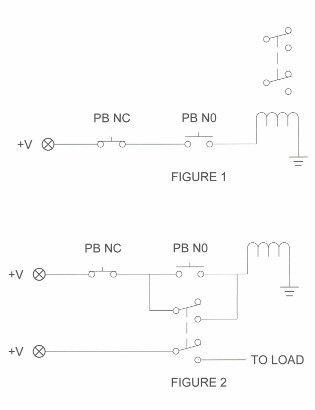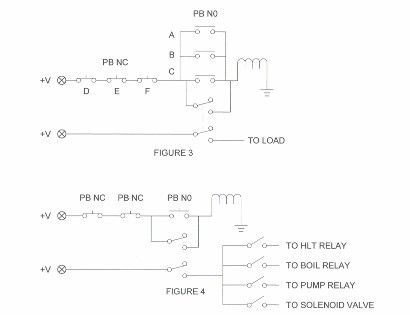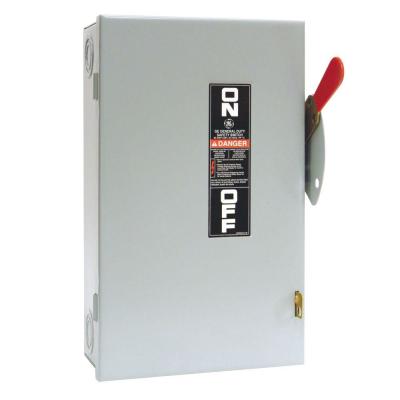RufusBrewer
Well-Known Member
Drawing from my past of working in industrial control, I present a tried and true method to create an E-Stop. We called this the "Master Relay". It was used on packing lines and we put E-Stop buttons up and down the line so anybody could hit a panic button and shut down the line in case of an emergency.
I present this in the hopes of drawing people away from employing the "pull the hot to ground and trip the GFI E-Stop" design. I am sorry, that is not what I consider a good, safe and reliable design.
So here I go....
Figure 1 is a DPDT relay with 2 momentary action push button switches between the coil and the voltage. One PB is Normally Closed (NC) the other is Normally Open (NO). Push the NO PB and the relay is turned on and the DPDT contacts switch. Release PB NO and the relay turns off and the contacts switch back to the off position.
In Figure 1, the NC PB has no practical function.

In Figure 2, I move the DPDT contacts. One set of contacts wrap around the NO PB. When you push the NO PB, the relay turns on, the contacts close. Let go of the NO PB and the relay stays on. (the NO PBi is bypassed by the relay contacts) IOW It is self latching. The second relay contacts make a SPDT switch that you can turn On/Off anything you like.
This is where the NC PB comes in. First: press the NO PB, the relay turns on, the relay self-latches. press the NC PB, the switch opens, current through the relay coil is killed, the relay turns off and the contacts go to the relay off position.
The buttons can be anythings you like. As long as they are momentary style buttons. If you want to use a big red mushroom "panic" button for the off switch you can do that.
You have made a spiffy On/Off switch. One button is On, the other button is Off. Spiffy, sure, but why go to all that trouble to make an On/Off switch? What else can you do with it?
Figure 3 shows that you can add multiple On/Off buttons. On buttons go on parallel with each other, Off buttons in series.
You can add them in any combination you like. 2 On buttons, + 3 Off buttons. You can turn the system on with any On button and turn it off with any Off button.
Put an On button & an Off button on your panel, add a second Off button anywhere else in your brewery. E.g. An Off button on the far end of your brewery, away from your panel. You can shut things down, pronto, without walking over to your panel.
The switches can be any switch rated to carry the relay coil voltage. Use a key switch in the Off series switches. If the key switch is off, you cannot turn it on. Or make use a door lock out as an Off switch, when the door is open, the system is shut down.

Figure 4 is an example of how you might use the switch. Use it to supply the control voltage for your SSR's. Put the coil for you 220 VAC contactor coil on the switched side and you can shut down all AC with the press of a button.
The current through the switches is the coil voltage only. If you use a 12 VDC relays you can safely run 12 VDC current all over you brewery.
The down side? You have to buy a relay and you need a power supply up and running in the first place to turn on the master relay.
I noticed one electric brewery supplier uses a variation of this switch. They run the coil current through the B-side of heater On/Off switches This forces you to have the heaters off before you can turn on the system. Clever and an excellent idea.
I present this in the hopes of drawing people away from employing the "pull the hot to ground and trip the GFI E-Stop" design. I am sorry, that is not what I consider a good, safe and reliable design.
So here I go....
Figure 1 is a DPDT relay with 2 momentary action push button switches between the coil and the voltage. One PB is Normally Closed (NC) the other is Normally Open (NO). Push the NO PB and the relay is turned on and the DPDT contacts switch. Release PB NO and the relay turns off and the contacts switch back to the off position.
In Figure 1, the NC PB has no practical function.

In Figure 2, I move the DPDT contacts. One set of contacts wrap around the NO PB. When you push the NO PB, the relay turns on, the contacts close. Let go of the NO PB and the relay stays on. (the NO PBi is bypassed by the relay contacts) IOW It is self latching. The second relay contacts make a SPDT switch that you can turn On/Off anything you like.
This is where the NC PB comes in. First: press the NO PB, the relay turns on, the relay self-latches. press the NC PB, the switch opens, current through the relay coil is killed, the relay turns off and the contacts go to the relay off position.
The buttons can be anythings you like. As long as they are momentary style buttons. If you want to use a big red mushroom "panic" button for the off switch you can do that.
You have made a spiffy On/Off switch. One button is On, the other button is Off. Spiffy, sure, but why go to all that trouble to make an On/Off switch? What else can you do with it?
Figure 3 shows that you can add multiple On/Off buttons. On buttons go on parallel with each other, Off buttons in series.
You can add them in any combination you like. 2 On buttons, + 3 Off buttons. You can turn the system on with any On button and turn it off with any Off button.
Put an On button & an Off button on your panel, add a second Off button anywhere else in your brewery. E.g. An Off button on the far end of your brewery, away from your panel. You can shut things down, pronto, without walking over to your panel.
The switches can be any switch rated to carry the relay coil voltage. Use a key switch in the Off series switches. If the key switch is off, you cannot turn it on. Or make use a door lock out as an Off switch, when the door is open, the system is shut down.

Figure 4 is an example of how you might use the switch. Use it to supply the control voltage for your SSR's. Put the coil for you 220 VAC contactor coil on the switched side and you can shut down all AC with the press of a button.
The current through the switches is the coil voltage only. If you use a 12 VDC relays you can safely run 12 VDC current all over you brewery.
The down side? You have to buy a relay and you need a power supply up and running in the first place to turn on the master relay.
I noticed one electric brewery supplier uses a variation of this switch. They run the coil current through the B-side of heater On/Off switches This forces you to have the heaters off before you can turn on the system. Clever and an excellent idea.




